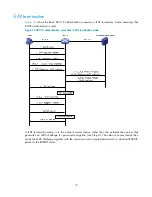
84
Use RADIUS servers to perform authentication, authorization, and accounting for the 802.1X users. If
RADIUS authentication fails, perform local authentication on the access device. If RADIUS accounting
fails, the access device logs the user off.
Configure the host at 10.1.1.1 as the primary authentication and accounting servers, and configure the
host at 10.1.1.2 as the secondary authentication and accounting servers. Assign all users to the ISP
domain
aabbcc.net
, which accommodates up to 30 users.
Configure the shared key as
name
for packets between the access device and the authentication server,
and configured the shared key as
money
for packets between the access device and the accounting
server.
Figure 33
Network diagram for 802.1X authentication configuration
Configuration procedure
NOTE:
For information about the RADIUS commands used on the access device in this example, see
Security
Command Reference.
1.
Configure the 802.1X client. If HP iNode is used, do not select the
Carry version info
option in the
client configuration. (Details not shown)
2.
Configure the RADIUS servers and add user accounts for the 802.1X users. (Details not shown)
3.
Assign an IP address for each interface on the access device. (Details not shown)
4.
Configure user accounts for the 802.1X users on the access device.
# Add a local user with the username
localuser
, and password
localpass
in plaintext. (Make sure that
the username and password are the same as those configured on the RADIUS server.)
<Device> system-view
[Device] local-user localuser
[Device-luser-localuser] service-type lan-access
[Device-luser-localuser] password simple localpass
# Configure the idle cut function to log off any online user who has been idle for 20 minutes.
[Device-luser-localuser] authorization-attribute idle-cut 20
[Device-luser-localuser] quit
5.
Configure a RADIUS scheme.
# Create the RADIUS scheme
radius1
and enter its view.
[Device] radius scheme radius1
Содержание A5830 Series
Страница 207: ...199 Figure 62 SFTP client interface ...






























